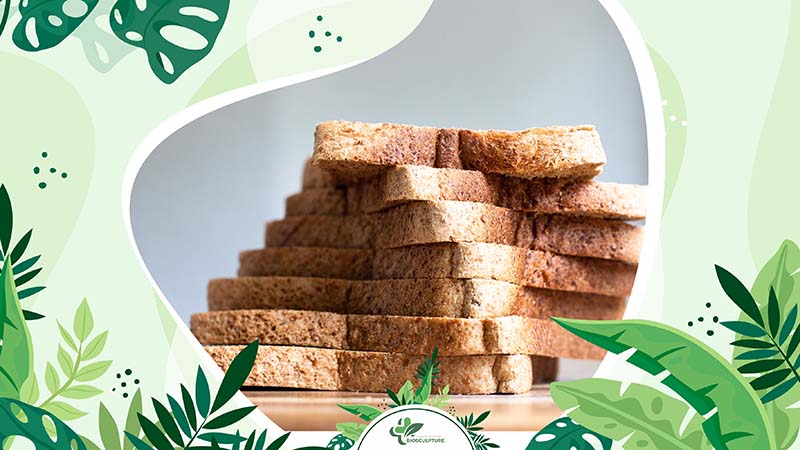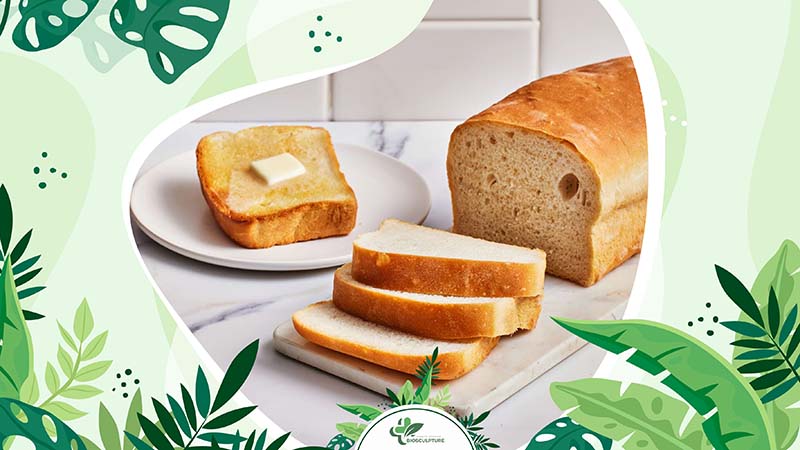Bread is a nutritious staple that can fit into any diet. It is made from various grains and comes in both whole and refined varieties. Nutrition experts advise opting for whole-grain bread more frequently, as it is richer in vitamins, minerals, and fiber. The nutritional content, including how many calories are in a slice of bread, varies depending on the brand and type. Let’s explore this topic surrounding bread in the article below from Biosculpture.

1. Exploring the Caloric Content of a Slice of Bread
When examining the caloric content of bread, a slice of commercially prepared whole wheat bread typically contains approximately 82 calories. Conversely, commercially prepared white bread offers slightly fewer calories, with around 75 calories per slice. White bread tends to have a bit more carbohydrates compared to whole-wheat bread, but its lower fiber content balances out the net carb intake, making it relatively similar.
Rye bread’s composition varies across brands, as it may be crafted from either whole grains or a blend of refined and whole grains. A standard slice of rye bread provides about 83 calories.

2. Health Benefits Associated with Bread
Bread serves as a valuable source of energy, primarily through carbohydrates, which are your body’s preferred fuel source. By incorporating bread into your diet, you’re supplying your body with the energy it needs for daily activities.
Opting for bread made from whole grains brings additional benefits, particularly for heart health. Whole grain varieties are rich in fiber, which has been linked to reducing the risk of cardiovascular disease. Studies suggest that consuming 28 to 30 grams of whole grains daily can contribute to lower total serum cholesterol and LDL cholesterol, commonly known as “bad” cholesterol.

Moreover, integrating whole grain bread into your diet may aid in blood sugar control and reduce the risk of type 2 diabetes. Research indicates that consuming 1.5 servings of whole grains, such as bread, daily can help regulate blood sugar and insulin levels.
For those aiming for weight loss, incorporating fiber-rich foods like bread is often recommended by weight loss experts. Fiber promotes a feeling of fullness, aiding in appetite control and potentially helping you consume fewer calories. Studies support the inclusion of whole grains in weight loss efforts, with individuals who consume more whole grains typically exhibiting lower body weight and more favorable body fat percentages compared to those who consume less.

3. Does Eating Sandwich Bread Contribute to Obesity?
Consuming white, packaged bread, which is often highly processed and laden with additives, can indeed contribute to various health concerns, including obesity, heart disease, and diabetes.
Even when opting for bread labeled as “whole grain,” this alone doesn’t ensure a healthy product. Many whole-grain bread varieties still contain a multitude of ingredients, including preservatives and added sugars and salts, not all of which contribute positively to health.
While preservatives aid in prolonging shelf life, individuals can opt for fresh bread with fewer preservatives and store it in the refrigerator or freezer to maintain freshness.
Pay attention to the amount of added sugar or sugar substitutes in bread. Ingredients such as corn syrup or those ending in “-ose” (like sucrose, glucose, and fructose) are forms of sugar that individuals should aim to limit in their diets.
When examining the ingredient list on bread packaging, remember that ingredients are typically listed by weight, with those at the top comprising higher proportions of the product. By scrutinizing these lists, individuals can make more informed choices about the bread they consume.
4. Guide on Consuming Bread Without Fear of Weight Gain
To enjoy bread without fear of weight gain, consider these expert tips:
- Follow the 10:1 Rule: Keep it simple by adhering to the 10:1 rule, suggests Rebecca Lewis, former head dietitian for HelloFresh. For every 10 grams of carbohydrates, aim for 1 gram of fiber. This guideline helps ensure you’re choosing bread with a good fiber-to-carb ratio.
- Prioritize Whole Grains: When selecting bread, always opt for whole grain varieties. Avoid products with ingredients like sugar, sucrose, fructose, corn syrup, white, or wheat flour listed near the top. According to Lewis, a food qualifies as “whole grain” only if the first ingredient reads “whole grain” or “whole wheat.” Be cautious with labels like “multigrain,” as they lack standardized definitions.
- Choose Organic Wheat: Dr. Taz, a weight-loss expert and author, recommends opting for organic wheat bread. Over the years, wheat has undergone significant changes, and organic options offer lower exposure to pesticides, providing a healthier alternative.
- Incorporate Bran, Barley, and Rye: Look for bread containing bran, barley, or rye, as they are rich in fiber. These grains contain beta-glucan, a soluble fiber that slows stomach emptying and helps regulate blood sugar levels, as explained by experts.
5. Nutrient-rich Varieties of Bread
Choosing nutrient-rich varieties of bread can significantly enhance your diet while minimizing the potential negative effects associated with less healthy options.

Whole-wheat bread stands out as a superior choice compared to white bread due to its higher fiber and protein content. These nutrients play a crucial role in slowing sugar absorption into the bloodstream, promoting stable blood sugar levels. Additionally, whole-wheat bread boasts a richer profile of essential nutrients like manganese and selenium, further contributing to your overall health.
Opting for bread made from sprouted grains, such as Ezekiel bread, presents another excellent opportunity to elevate the nutritional value of your bread. The sprouting process involves soaking and rinsing grains over several days, enhancing digestibility and nutrient absorption. Studies indicate that sprouted bread contains increased levels of fiber, folate, vitamin E, vitamin C, and beta-carotene, while also containing fewer antinutrients.
6. Proper Bread Storage Guide
To ensure your bread stays fresh for longer periods, consider these straightforward storage tips:
- Avoid Refrigeration: Refrigerating bread accelerates staling by causing moisture loss. Instead, opt for freezing to maintain freshness.
- Freeze Bread: Freeze entire loaves or individual slices in freezer bags for up to two months. Freezing locks in moisture, preserving the bread’s texture and taste.
- Minimize Slicing: Only slice bread when needed to prevent moisture loss. Store the whole loaf in an airtight container until ready to use.
- Press Cut Sides Together: After slicing, press the cut sides of the bread together to retain moisture.
- Repurpose Stale Bread: Transform stale bread into breadcrumbs, croutons, or stuffing to minimize waste.
- Utilize a Bread Box: Bread boxes provide a semi-sealed environment that slows moisture loss, maintaining freshness longer than leaving bread exposed.
- Wrap Bread: Reduce air circulation by tightly wrapping bread in aluminum foil or sealed plastic bags. Plastic wrap offers the most secure option for preserving freshness.
7. Conclusion
In conclusion, bread is high in carbohydrates and typically low in micronutrients. For some individuals, its gluten and antinutrient contents may pose health issues. However, many types of bread are enriched with additional nutrients, and choosing whole-grain or sprouted varieties can offer several health benefits. When consumed in moderation, bread can be part of a healthy diet.
To ensure maximum health benefits, it’s advisable to opt for healthier choices like whole-wheat or sprouted bread. Additionally, when considering portion control, it’s useful to ask: how many calories are in a slice of bread? Pairing these healthier options with a balanced diet is optimal.


